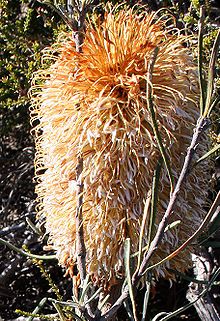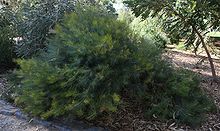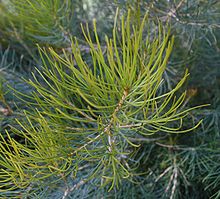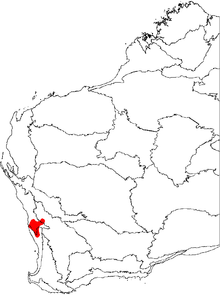- Banksia grossa
-
Banksia grossa 
B. grossa in natural habitat, north of Badgingarra Scientific classification Kingdom: Plantae (unranked): Angiosperms (unranked): Eudicots Order: Proteales Family: Proteaceae Genus: Banksia Species: B. grossa Binomial name Banksia grossa
A.S.GeorgeBanksia grossa, commonly known as Coarse Banksia is a species of shrub in the plant family Proteaceae endemic to south west Western Australia. One of fourteen species of banksia with predominantly round or oval inflorescences of the series Abietinae, it was described in 1981 as a distinct species by Alex George. Found in sand among heath between Eneabba and Badgingarra in Western Australia, it grows as a shrub to 1 m (3 ft) high with narrow leaves and oval brownish flower spikes composed of hundreds of individual flowers.
Contents
Description
Banksia grossa grows as a lignotuberous shrub up to a metre high. Young stems have a coating of woolly hairs, older stems flaky pale brown bark. The leaves are needle-like, being from 4 to 12 cm (1.6-4.6 in) long, and only 2 to 3 mm wide, on a petiole from 3 to 5 mm long. The margins are linear and inrolled, and the upper surface is sparsely hairy when young, but later hairless.[1]
Flowers occur in a typical Banksia flower spike, an inflorescence made up of hundreds of small individual flowers, or florets, densely packed around a cylindrical axis. In B. grossa is this 5 to 7 centimetres high. Flowers are rusty brown to golden brown, with dark red to purple styles that are not revealed until the flower fully opens.[1]
Flowering occurs between March and September. It takes five to eight weeks for a flower to develop from bud to the end of flowering. About three weeks before the flowers open, they develop a strong musky smell. The opening of flowers, known as anthesis, occurs sequentially, starting at the bottom of the inflorescence and sweeping through to the top over a period of around two weeks. At anthesis the flowers produce unusually large quantities of nectar; indeed some flowers produce so much that it drips to the ground.[2] After flowering the old withered florets persist on the spike, giving it a hairy appearance. Up to 25 smooth, elliptical follicles develop in the spike, each containing up to two wide wedge-shaped winged seeds.[1]
Taxonomy
The first known specimen collection of B. grossa was made by botanist Fred W. Humphreys in 1965. Alex George has expressed surprise that it was not collected by earlier visitors to the area, speculating that "perhaps they were diverted by its similarity to B. leptophylla and B. sphaerocarpa." George formally described the species in his 1981 monograph "The genus Banksia L.f. (Proteaceae)", based on a specimen collected by him on the Brand Highway, 76 km north of Regans Ford, on 14 May 1969. He placed it in subgenus Banksia because of its flower spike; section Oncostylis because its styles are hooked; and the resurrected series Abietinae, which he constrained to contain only round-fruited species. It was placed in phyletic order between B. micrantha and B. leptophylla. The specific epithet is from the Latin grossus ("coarse") and refers to the leaves, flowers and fruit, all of which George thought more coarse than other members of B. ser. Abietinae.[3]
George's arrangement remained current until 1996, when Kevin Thiele and Pauline Ladiges published an arrangement informed by a cladistic analysis of morphological characteristics. They retained George's subgenera and many of his series, but discarded his sections. Banksia ser. Abietinae was found to be very nearly monophyletic, and so retained. It further resolved into four subclades, so Thiele and Ladiges split it into four subseries. B. grossa appeared as the most basal member of the second of these:
B. grossa
This clade became the basis for the new subseries Sphaerocarpae, which Thiele defined as containing those species with lignotubers, styles loosely curling around the infructescence (although this trait was reversed in micrantha), and "transversely aligned cells of the seed wing inner face". Other than B. grossa, these species also have shouldered follicles.[4]
Questioning the emphasis on cladistics in Thiele and Ladiges' arrangement, George published a slightly modified version of his 1981 arrangement in his 1999 treatment of Banksia for the Flora of Australia series of monographs. B. grossa's placement was the same as in 1981, except that B. telmatiaea was moved to set between it and B. leptophylla. The placement of B. sphaerocarpa in George's 1999 arrangement may be summarised as follows:[1]
- Banksia
- B. subg. Banksia
- B. sect. Banksia (9 series, 50 species, 9 subspecies, 3 varieties)
- B. sect. Coccinea (1 species)
- B. sect. Oncostylis
- B. ser. Spicigerae (7 species, 2 subspecies, 4 varieties)
- B. ser. Tricuspidae (1 species)
- B. ser. Dryandroideae (1 species)
- B. ser. Abietinae
- B. sphaerocarpa (5 varieties)
- B. micrantha
- B. grossa
- B. telmatiaea
- B. leptophylla (2 varieties)
- B. lanata
- B. scabrella
- B. violacea
- B. incana
- B. laricina
- B. pulchella
- B. meisneri (2 subspecies)
- B. nutans (2 varieties)
- B. subg. Isostylis (3 species)
- B. subg. Banksia
Since 1998, Austin Mast has been publishing results of ongoing cladistic analyses of DNA sequence data for the subtribe Banksiinae. His analyses suggest a phylogeny that is very different to George's arrangement. B. grossa was inferred as sister to a polytomous clade consisting of B. leptophylla, B. telmatiaea, B. scabrella and B. lanata:[5][6][7]
B. telmatiaea
B. grossa
Early in 2007, Mast and Thiele initiated a rearrangement of Banksia by merging Dryandra into it, and publishing B. subg. Spathulatae for the taxa having spoon-shaped cotyledons. They foreshadowed publishing a full arrangement once DNA sampling of Dryandra was complete; in the meantime, if Mast and Thiele's nomenclatural changes are taken as an interim arrangement, then B. grossa is placed in B. subg. Spathulatae.[8]
Distribution and habitat
Banksia grossa mainly occurs from west of Yandanooka in the north, south to Badgingarra National Park, and east almost to Coorow. It grows in shallow sand over laterite, in deep sand, and occasionally atop lateritic rises, on flat or gently undulating land, among kwongan shrubland.[1][9]
Ecology
The inflorescences are highly attractive to insects.[2] Large numbers of ladybirds have been reported drinking the nectar of this species, while ignoring nearby Banksia attenuata inflorescences.[2] No pollinators were recorded in The Banksia Atlas survey.[9]
Banksia grossa is one of five closely related Banksia species that have highly unusual flower nectar. Whereas other Banksia species produce nectar that is clear and watery, the nectar of these species is pale yellow initially, but gradually becomes darker and thicker, changing to a thick, olive-green mucilage within one to two days of secretion, and eventually becoming "an almost black, gelatinous lump adhering to the base of the flowers".[10] It was first noted by Byron Lamont in 1980; he attributed it to cyanobacteria that feed off the nectar sugars. Noting that many of these cyanobacteria had heterocysts, he speculated that they aid the plant by fixing atmospheric nitrogen, which is then washed off the flower heads by rain, and absorbed by the proteoid root mat. This purported symbiosis was investigated by Barrett and Lamont in 1985, but no evidence of nitrogen fixing was found.[11] Further investigation by Markey and Lamont in 1996 suggested that the discolouration is not caused by cyanobacteria or other microorganisms in the nectar, but is rather "a chemical phenomenon of plant origin". Their analyses indicated that the nectar had unusually high levels of sugar and free amino acids,[2] but three of these species, including B. sphaerocarpa, have since been shown to have normal nectar sugar compositions.[12]
Cultivation
Banksia grossa is cultivated for its attractive needle-like leaves and rusty-brown flower spikes, both of which can be quite variable in colour. This species favours well-drained sandy or loamy acidic soils, with a sunny aspect. Once established it tolerates dry spells. It can be pruned heavily as it resprouts from its lignotuber.[13]
Propagation is by seed.[13] The seeds do not require any treatment prior to sowing, and take around 14 days to germinate.[14] This is a slow-growing plant, taking 5 to 7 years to reach maturity and begin flowering.
References
- ^ a b c d e George, Alex S. (1999). "Banksia". In Wilson, Annette (ed.). Flora of Australia. 17B. Collingwood, Victoria: CSIRO Publishing / Australian Biological Resources Study. pp. 175–251. ISBN 0-643-06454-0.
- ^ a b c d Markey, Adrienne S.; Byron B. Lamont (1996). "Why do some banksias have green nectar?". International Symposium on the Biology of Proteaceae. Royal Botanic Gardens, Melbourne.
- ^ George, Alex S. (1981). "The genus Banksia L.f. (Proteaceae)". Nuytsia 3 (3): 239–473. ISSN 0085-4417.
- ^ Thiele, Kevin; Ladiges, Pauline Y. (1996). "A Cladistic Analysis of Banksia (Proteaceae)". Australian Systematic Botany 9 (5): 661–733. doi:10.1071/SB9960661.
- ^ Mast, Austin R. (1998). "Molecular systematics of subtribe Banksiinae (Banksia and Dryandra; Proteaceae) based on cpDNA and nrDNA sequence data: implications for taxonomy and biogeography". Australian Systematic Botany 11 (4): 321–342. doi:10.1071/SB97026.
- ^ Mast, Austin R.; Givnish, Thomas J. (2002). "Historical biogeography and the origin of stomatal distributions in Banksia and Dryandra (Proteaceae) based on Their cpDNA phylogeny". American Journal of Botany 89 (8): 1311–1323. doi:10.3732/ajb.89.8.1311. ISSN 0002-9122. PMID 21665734. http://www.amjbot.org/cgi/content/full/89/8/1311. Retrieved 2006-07-02.
- ^ Mast, Austin R.; Jones, Eric H.; Havery, Shawn P. (2005). "An assessment of old and new DNA sequence evidence for the paraphyly of Banksia with respect to Dryandra (Proteaceae)". Australian Systematic Botany (CSIRO Publishing / Australian Systematic Botany Society) 18 (1): 75–88. doi:10.1071/SB04015.
- ^ Mast, Austin R.; Thiele, Kevin (2007). "The transfer of Dryandra R.Br. to Banksia L.f. (Proteaceae)". Australian Systematic Botany 20: 63–71. doi:10.1071/SB06016.
- ^ a b Taylor, Anne; Hopper, Stephen (1988). The Banksia Atlas (Australian Flora and Fauna Series Number 8). Canberra: Australian Government Publishing Service. pp. 116–17. ISBN 0-644-07124-9.
- ^ Lamont, Byron B. (1980). "Blue-green algae in nectar of Banksia aff. Sphaerocarpa". West Australian Naturalist 14 (7): 193–194.
- ^ Barrett, Gregory J.; Lamont, Byron B. (1985). "Absence of nitrogen fixation (acetylene reduction) by procaryotes in nectar of Banksias". Plant and Soil 85 (3): 443–45. doi:10.1007/BF02220200.
- ^ Nicolson, Susan W.; Van Wyk, Ben-Erik (1998). "Nectar sugars in Proteaceae: Patterns and processes". Australian Journal of Botany 46 (4): 489–504. doi:10.1071/BT97039.
- ^ a b Collins, Kevin; Collins, Kathy (2008). Banksias. Melbourne, Victoria: Bloomings Books. pp. 53, 304–05. ISBN 1876473686.
- ^ Sweedman, Luke; et al. (2006). Australian seeds: a guide to their collection, identification and biology. CSIRO Publishing. p. 203. ISBN 0643092986.
External links
- "Banksia grossa". Flora of Australia Online. Department of the Environment and Heritage, Australian Government. http://www.anbg.gov.au/abrs/online-resources/flora/stddisplay.xsql?pnid=46192.
- "Banksia grossa". FloraBase. Department of Environment and Conservation, Government of Western Australia. http://florabase.dec.wa.gov.au/browse/profile/1820.
Categories:- Banksia taxa by scientific name
- Eudicots of Western Australia
- Plants described in 1981
- Banksia
Wikimedia Foundation. 2010.



